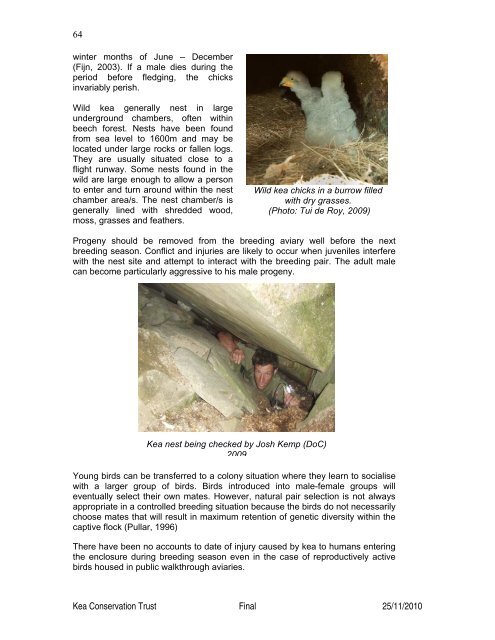(Nestor notabilis) Husbandry Manual - Kea Conservation Trust
(Nestor notabilis) Husbandry Manual - Kea Conservation Trust
(Nestor notabilis) Husbandry Manual - Kea Conservation Trust
Create successful ePaper yourself
Turn your PDF publications into a flip-book with our unique Google optimized e-Paper software.
64<br />
winter months of June – December<br />
(Fijn, 2003). If a male dies during the<br />
period before fledging, the chicks<br />
invariably perish.<br />
Wild kea generally nest in large<br />
underground chambers, often within<br />
beech forest. Nests have been found<br />
from sea level to 1600m and may be<br />
located under large rocks or fallen logs.<br />
They are usually situated close to a<br />
flight runway. Some nests found in the<br />
wild are large enough to allow a person<br />
to enter and turn around within the nest<br />
chamber area/s. The nest chamber/s is<br />
generally lined with shredded wood,<br />
moss, grasses and feathers.<br />
Wild kea chicks in a burrow filled<br />
with dry grasses.<br />
(Photo: Tui de Roy, 2009)<br />
Progeny should be removed from the breeding aviary well before the next<br />
breeding season. Conflict and injuries are likely to occur when juveniles interfere<br />
with the nest site and attempt to interact with the breeding pair. The adult male<br />
can become particularly aggressive to his male progeny.<br />
<strong>Kea</strong> nest being checked by Josh Kemp (DoC)<br />
2009<br />
Young birds can be transferred to a colony situation where they learn to socialise<br />
with a larger group of birds. Birds introduced into male-female groups will<br />
eventually select their own mates. However, natural pair selection is not always<br />
appropriate in a controlled breeding situation because the birds do not necessarily<br />
choose mates that will result in maximum retention of genetic diversity within the<br />
captive flock (Pullar, 1996)<br />
There have been no accounts to date of injury caused by kea to humans entering<br />
the enclosure during breeding season even in the case of reproductively active<br />
birds housed in public walkthrough aviaries.<br />
<strong>Kea</strong> <strong>Conservation</strong> <strong>Trust</strong> Final 25/11/2010












